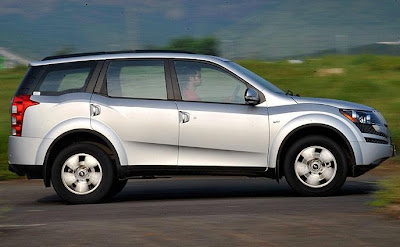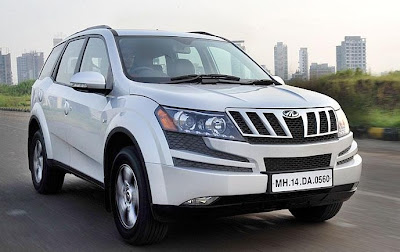Sure there’s a lot of respect for the Japanese company and plenty of respect for the Pajero brand name as well, but yes – Pajero, Montero, Outlander and now a Pajero Sport – that’s a lot of SUVs, which is puzzling. Of course the real reason the Pajero Sport exists is to take on competition like the Fortuner and Endeavour. It’s all about delivering as much SUV as you can on a budget. All three are based on light pick-up trucks sold en masse in Thailand, each is similarly specified and, all of them have attained their fair share of success in the region. The Pajero Sport, importantly, is also a thoroughly modern, up-to-the-minute, common-rail-diesel-equipped SUV; something HM Mitsubishi’s mountain goat, the Pajero, certainly isn’t. Put simply, what Mitsubishi is trying to do is deliver a Montero-like package at a Pajero-like price; that’s as close as you can get to a surefire recipe for success in India.
Under the microscope
Mitsubishi hasn’t done as well as it could have in India and so it’s easy to forget how impressive the company is with SUVs. Sure, the Japanese company makes some very capable compacts, saloons, and sports cars, and some of them are exceptional too, but it’s the SUVs that get special attention at Mitsubishi. They are thoroughly engineered, the company’s knowledge base on off-roaders is second to none and Mitsubishi is hungry for success.
So hungry, in fact, that its designers have lifted the nose section right off the Pajero Evo rally car and grafted it directly onto the new Pajero Sport. The grille and headlights are aligned in a single narrow band, the massive wheel arches on either side provide plenty of excitement and the gaping chasm below the bumper gives the SUV a tough, purposeful look. The cabin gets tighter and tapers towards the rear, the taillights are attractive and the Sport sits so high on its springs, it looks like it’s been given an aftermarket suspension job. Overall proportions, however, aren’t great, as the stubby nose and large cabin don’t exactly gel.
Delve deeper and you come across the modified Triton truck chassis on which the engine, transmission, transfer cases and body are all bolted. Suspension at the front is handled by double wishbones, there are stout anti-roll bars at both ends (important considering how high off the ground this car sits) and the non-independent rear uses a three-link setup. Mitsubishi’s ‘Super Select’ transfer case allows you to shift from two-wheel drive high to four-wheel drive high on the move (upto speeds as high as 100kph), and you can uniquely lock the centre diff in both four-wheel high and four-wheel low.
I step into the cabin and am pleasantly surprised. The dash is beautifully designed, good use has been made of the numerous textures and colours, and the quality of some of the bits is surprisingly good as well. The leather-covered steering wheel, for example, is superbly crafted, the doorpads look like they are from a more expensive SUV, and the central console with its multi-information display both looks good and has plenty of useful information on offer. Both the driver and passenger get powered seats, thigh and back support are good up front and there’s even plenty of legroom for tall passengers in the second row. Those sat in this row can also adjust the angle of the backrest, their thighs are well supported and visibility from the back is pretty good too. The Sport does feel a bit narrow though, and that means sitting three abreast is not as comfortable as it could have been. And while access to the third row is relatively easy and the middle-row seats flip beautifully upon pulling a lever, the space in the rear is only really useable by children. The cabin has plenty of storage, especially, in and around the central console, and there’s even space for some luggage in the rear.
A question of Sport
The Pajero Sport’s 2.5-litre diesel may be smaller than its competitors, but what it loses in capacity it more than makes up for in specific output. Its 176bhp is very similar to the 168bhp put out by the Toyota Fortuner’s larger 3.0-litre engine and acceleration and performance are pretty similar as well. The Mitsubishi’s variable-geometry turbo has been tuned with performance in mind and after a small amount of vibration and some initial lag, power is delivered in a strong and steady stream all the way from 1800 to 4500rpm. The engine feels very smooth in the mid-range, there is considerable punch when you keep your foot pinned down, and after 100kph the Sport pulls away from its rivals with effortless ease. The engine is also particularly effective on the highway. As long as you are somewhere in the mid-range, there’s always plenty of punch available for overtaking. And because the motor always seems to have more to give, performance really does feel quite effortless. This is clearly Mitsubishi’s best diesel engine yet. What’s also impressive is the integration of the gearbox, the short gearing masking a bit of the turbo lag. The gearbox does have a typically long throw, but it’s light to operate and gears slot in perfectly every time. This helps when you want to go a gear lower in traffic.
With so much daylight between the wheels and the wheel arches, the Pajero rides well on its tall springs as well. You can drive the Sport through some of the largest craters around and the suspension will take it in its stride. Come to think of it, this would be an ideal car in which to tackle long stretches of broken tarmac, the rubber-footed suspension just soaking everything up. Stability at speed is surprisingly good too. It feels perfectly calm and composed, even at triple-digit speeds speeds, small directional changes are executed with little vagueness or lag, and the well-weighted brakes allow you to bleed speed in a drama-free manner too. Also impressive is the feelsome steering. It does feel a bit weighty at parking speeds, but as soon as you are up and running, the feel and feedback are exactly what you want. But while the Sport does have a reasonable amount of grip in corners and the feedback from the steering is good, it feels too top-heavy to corner with confidence. It’s the tall, off-road suspension setup that’s to blame. So the best way to tackle corners is to slow right down, gently tip the car in, and allow it to follow a smooth line out.
Executive Briefing
The Pajero Sport has a lot going for it. It has a strong diesel engine, a spacious and comfortable cabin, and impressive levels of fit and finish. It is well specified and comes from a long line of successful Mitsubishi SUVs. What might let it down though, is that at Rs 23.5 lakh (ex-showroom, Delhi), it is approximately Rs 2.5 lakh more than the Toyota Fortuner, which means it is a contender, but a pricey one. Its handling may not be anywhere as sharp as we’d hoped and it can’t be bought with an automatic yet, but looked at as an overall package, it’s impressive enough to take on the best in its class. Mitsubishi and the once popular Pajero sure have come a long way. Source
Under the microscope
Mitsubishi hasn’t done as well as it could have in India and so it’s easy to forget how impressive the company is with SUVs. Sure, the Japanese company makes some very capable compacts, saloons, and sports cars, and some of them are exceptional too, but it’s the SUVs that get special attention at Mitsubishi. They are thoroughly engineered, the company’s knowledge base on off-roaders is second to none and Mitsubishi is hungry for success.
So hungry, in fact, that its designers have lifted the nose section right off the Pajero Evo rally car and grafted it directly onto the new Pajero Sport. The grille and headlights are aligned in a single narrow band, the massive wheel arches on either side provide plenty of excitement and the gaping chasm below the bumper gives the SUV a tough, purposeful look. The cabin gets tighter and tapers towards the rear, the taillights are attractive and the Sport sits so high on its springs, it looks like it’s been given an aftermarket suspension job. Overall proportions, however, aren’t great, as the stubby nose and large cabin don’t exactly gel.
Delve deeper and you come across the modified Triton truck chassis on which the engine, transmission, transfer cases and body are all bolted. Suspension at the front is handled by double wishbones, there are stout anti-roll bars at both ends (important considering how high off the ground this car sits) and the non-independent rear uses a three-link setup. Mitsubishi’s ‘Super Select’ transfer case allows you to shift from two-wheel drive high to four-wheel drive high on the move (upto speeds as high as 100kph), and you can uniquely lock the centre diff in both four-wheel high and four-wheel low.
I step into the cabin and am pleasantly surprised. The dash is beautifully designed, good use has been made of the numerous textures and colours, and the quality of some of the bits is surprisingly good as well. The leather-covered steering wheel, for example, is superbly crafted, the doorpads look like they are from a more expensive SUV, and the central console with its multi-information display both looks good and has plenty of useful information on offer. Both the driver and passenger get powered seats, thigh and back support are good up front and there’s even plenty of legroom for tall passengers in the second row. Those sat in this row can also adjust the angle of the backrest, their thighs are well supported and visibility from the back is pretty good too. The Sport does feel a bit narrow though, and that means sitting three abreast is not as comfortable as it could have been. And while access to the third row is relatively easy and the middle-row seats flip beautifully upon pulling a lever, the space in the rear is only really useable by children. The cabin has plenty of storage, especially, in and around the central console, and there’s even space for some luggage in the rear.
A question of Sport
With so much daylight between the wheels and the wheel arches, the Pajero rides well on its tall springs as well. You can drive the Sport through some of the largest craters around and the suspension will take it in its stride. Come to think of it, this would be an ideal car in which to tackle long stretches of broken tarmac, the rubber-footed suspension just soaking everything up. Stability at speed is surprisingly good too. It feels perfectly calm and composed, even at triple-digit speeds speeds, small directional changes are executed with little vagueness or lag, and the well-weighted brakes allow you to bleed speed in a drama-free manner too. Also impressive is the feelsome steering. It does feel a bit weighty at parking speeds, but as soon as you are up and running, the feel and feedback are exactly what you want. But while the Sport does have a reasonable amount of grip in corners and the feedback from the steering is good, it feels too top-heavy to corner with confidence. It’s the tall, off-road suspension setup that’s to blame. So the best way to tackle corners is to slow right down, gently tip the car in, and allow it to follow a smooth line out.
Executive Briefing
The Pajero Sport has a lot going for it. It has a strong diesel engine, a spacious and comfortable cabin, and impressive levels of fit and finish. It is well specified and comes from a long line of successful Mitsubishi SUVs. What might let it down though, is that at Rs 23.5 lakh (ex-showroom, Delhi), it is approximately Rs 2.5 lakh more than the Toyota Fortuner, which means it is a contender, but a pricey one. Its handling may not be anywhere as sharp as we’d hoped and it can’t be bought with an automatic yet, but looked at as an overall package, it’s impressive enough to take on the best in its class. Mitsubishi and the once popular Pajero sure have come a long way. Source
 RSS Feed
RSS Feed Twitter
Twitter






 Tuesday, May 01, 2012
Tuesday, May 01, 2012
 Samipodo
Samipodo









